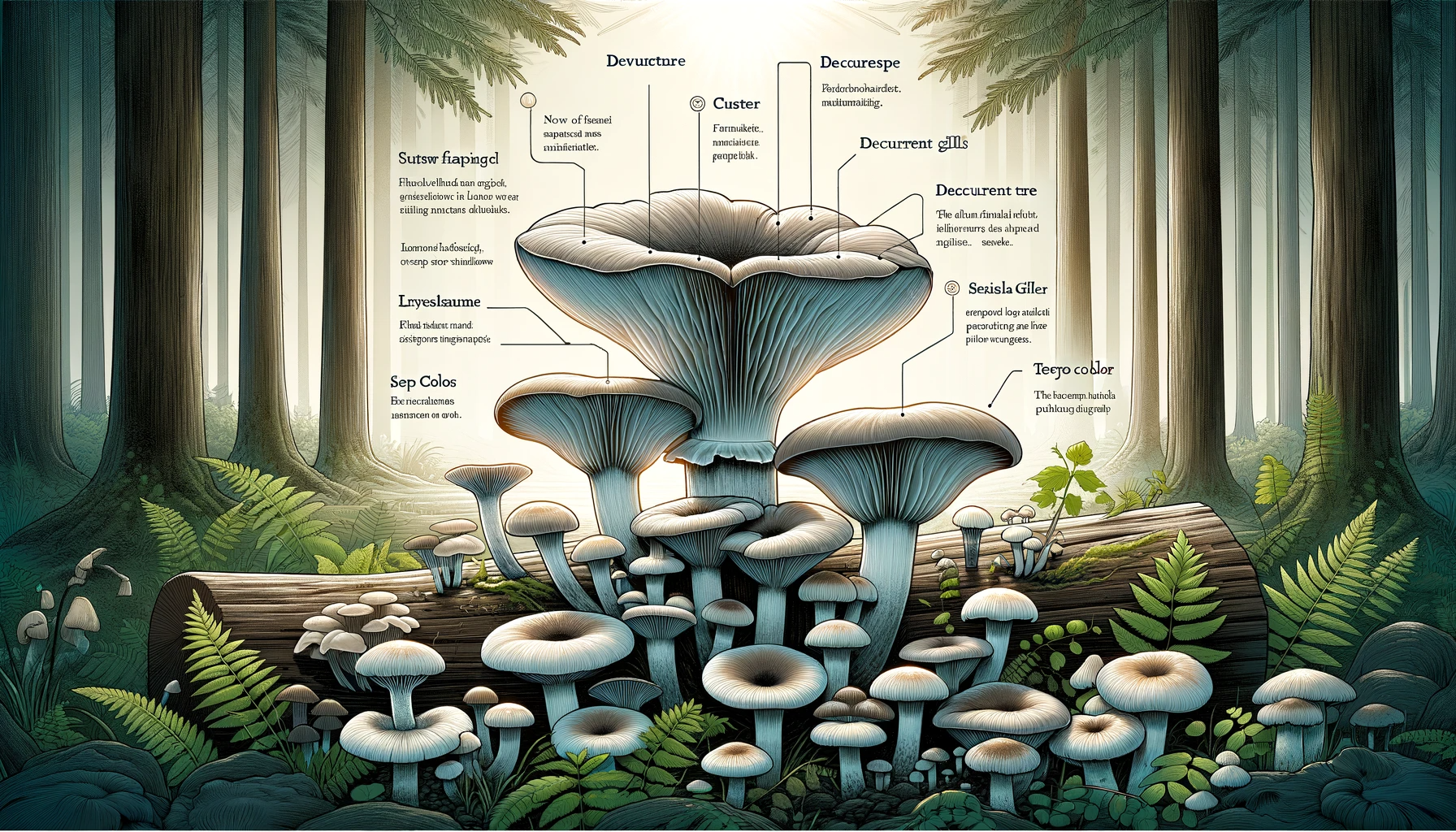Oyster mushrooms (Pleurotus ostreatus) are one of the most popular and easily identifiable mushrooms, cherished for their culinary and medicinal properties. Found widely across the world, they are known for their unique shape and growing habits, thriving on dead and decaying wood. This guide aims to equip mushroom enthusiasts and foragers with essential information for the accurate identification of oyster mushrooms.
Physical Characteristics
Cap
- Shape: The cap of an oyster mushroom resembles an oyster or a fan and is typically 5-25 cm in diameter.
- Color: It varies from white, gray, to brownish, often lighter towards the edges.
- Surface: Smooth and sometimes slightly lobed or wavy.
Gills
- Structure: The gills of oyster mushrooms are decurrent, running down the stem (if present).
- Color: They are usually white or cream-colored.
Stem
- Presence: The stem is often absent or rudimentary. When present, it’s eccentrically attached (not central).
- Texture: It is firm and white, though not as fleshy as the cap.
Spore Print
- An essential characteristic for identification, the spore print of the oyster mushroom is white to lilac-gray.
Habitat and Season
Oyster mushrooms prefer temperate and subtropical environments. They are saprobic, growing on dead and decaying wood, particularly on hardwoods. They are commonly found on fallen logs, stumps, and even on living trees that are in decline. The typical foraging season is late fall to early winter, but in some climates, they can be found year-round.
Culinary Uses
Oyster mushrooms are highly prized in the kitchen. They have a mild flavor and a tender, yet chewy texture. They are excellent in stir-fries, soups, and as meat substitutes in various dishes.
Medicinal Properties
Traditionally, oyster mushrooms have been used for their medicinal properties. They are believed to help lower cholesterol levels and boost immune system function. Recent studies have also explored their potential in anti-cancer therapies.
Look-alikes and Safety
While oyster mushrooms are generally easy to identify, they do have look-alikes, such as the poisonous Pleurocybella porrigens. It is crucial to note the differences:
- Pleurocybella porrigens has a much thinner and more fragile cap.
- It grows primarily on conifer wood, unlike the hardwood preference of oyster mushrooms.
For safety, always consult with an expert or use a reliable field guide when foraging mushrooms. Never consume a mushroom unless you are 100% sure of its identification.
Conclusion
Oyster mushrooms, with their distinct features and multiple benefits, are a great find for foragers and mushroom enthusiasts. Proper identification is key to safely enjoying their culinary and medicinal benefits. Remember, when in doubt, it’s wise to err on the side of caution and seek expert advice.
Happy foraging!
FAQs
Q1: How can I recognize an oyster mushroom?
- A: Look for a fan or oyster-shaped cap, usually 5-25 cm in diameter, with colors ranging from white to gray or brownish. The gills are decurrent, running down the stem if present, which is often rudimentary. The spore print is typically white to lilac-gray.
Q2: Where do oyster mushrooms typically grow?
- A: Oyster mushrooms grow on dead and decaying wood, especially hardwoods. They are found on fallen logs, stumps, and sometimes on living trees that are in decline. They prefer temperate and subtropical environments.
Q3: When is the best time to forage for oyster mushrooms?
- A: The typical season for oyster mushrooms is late fall to early winter, but in some climates, they can be found year-round.
Q4: Are oyster mushrooms edible and safe?
- A: Yes, oyster mushrooms are edible and highly valued in culinary uses for their mild flavor and tender texture. However, always ensure accurate identification, as there are poisonous look-alikes.
Q5: What are the medicinal benefits of oyster mushrooms?
- A: Oyster mushrooms are believed to help lower cholesterol levels and boost the immune system. They are also being studied for potential anti-cancer properties.
Q6: How do I differentiate oyster mushrooms from their poisonous look-alikes?
- A: Compare the thickness of the cap and the type of wood they grow on. Poisonous look-alikes, like Pleurocybella porrigens, have thinner caps and typically grow on conifer wood, whereas oyster mushrooms grow on hardwood.
Q7: Can I cultivate oyster mushrooms at home?
- A: Yes, oyster mushrooms are one of the easiest mushrooms to cultivate at home using mushroom growing kits or DIY methods with substrates like straw or coffee grounds.

Alex is a seasoned writer and researcher, specializing in psychedelic studies and mental health. Known for insightful and authoritative content, he combines extensive knowledge with a passion for exploring wellness and alternative therapies. Alex’s work is a trusted resource for readers delving into the world of mental well-being.


Leave a Reply